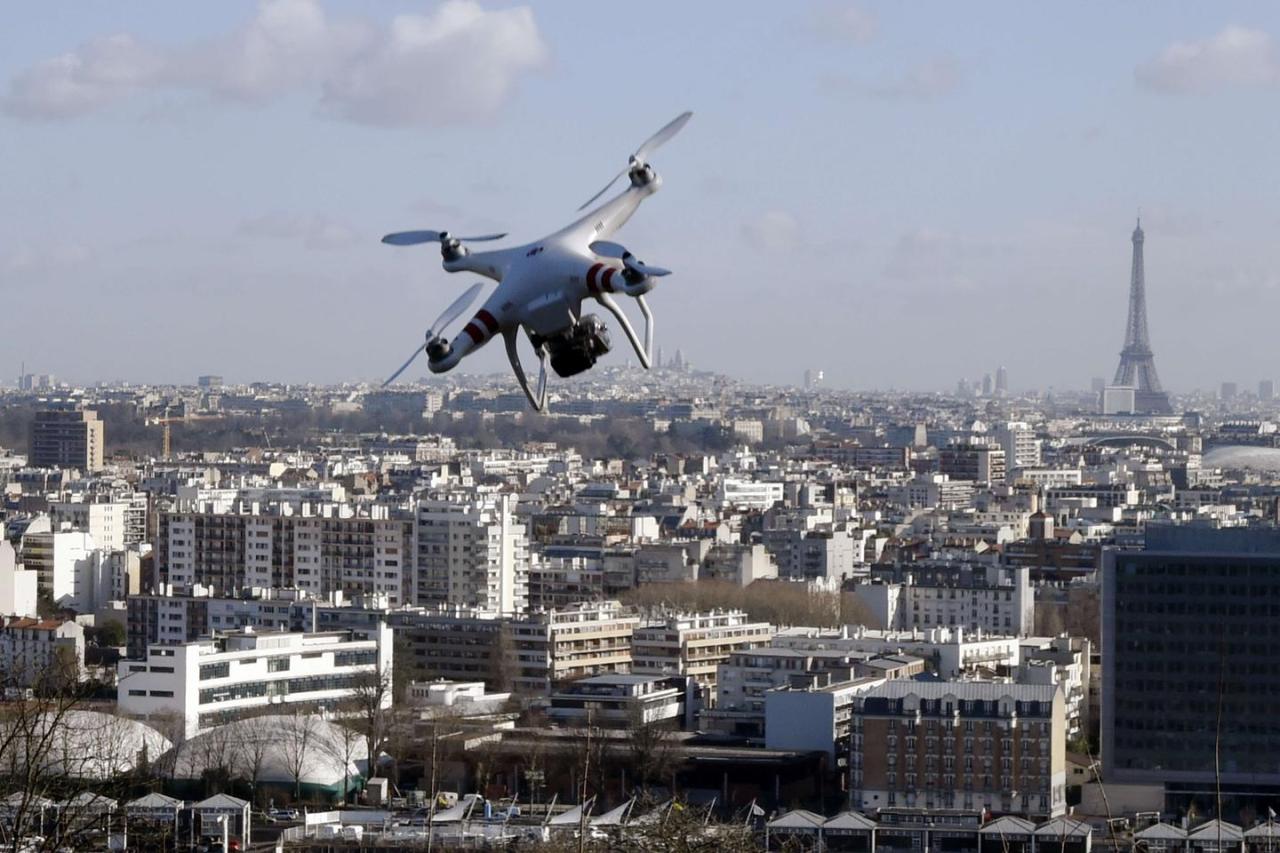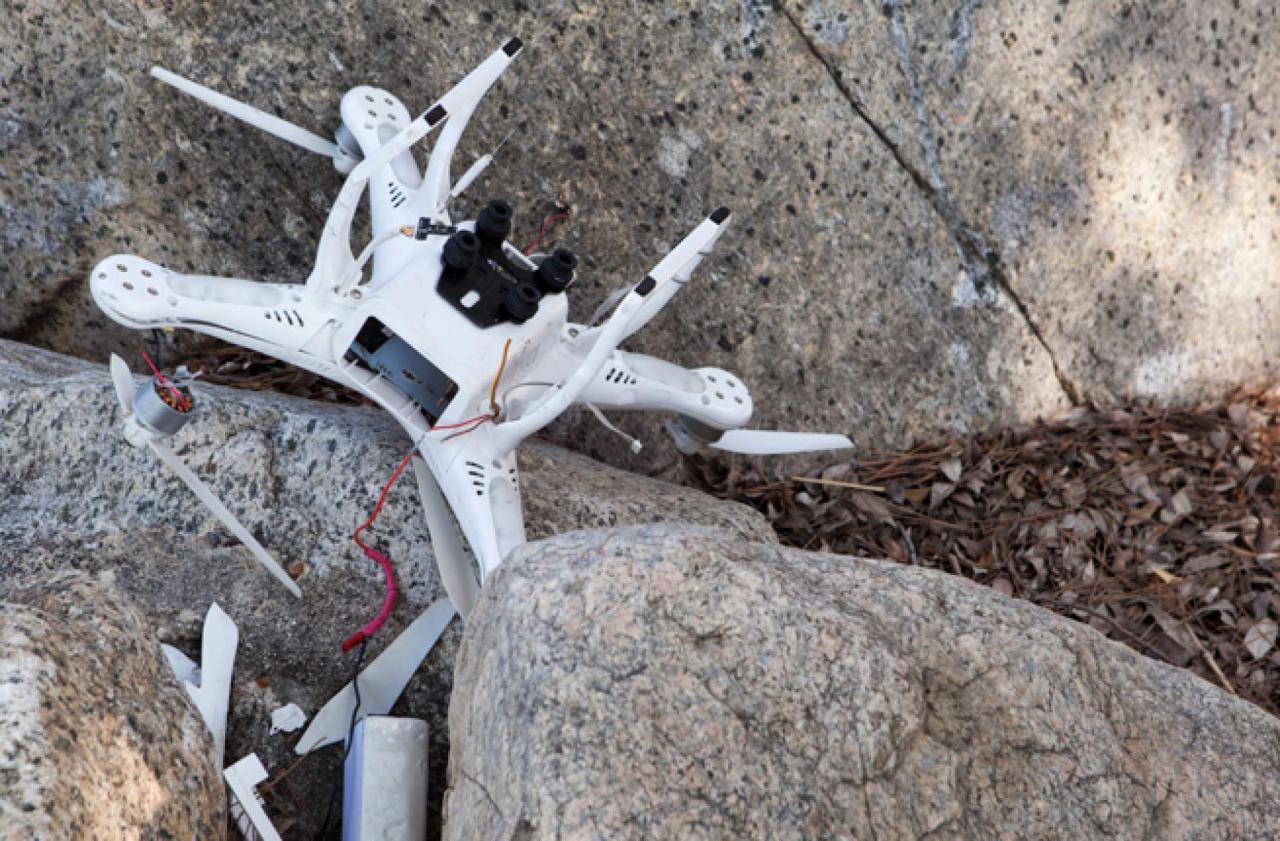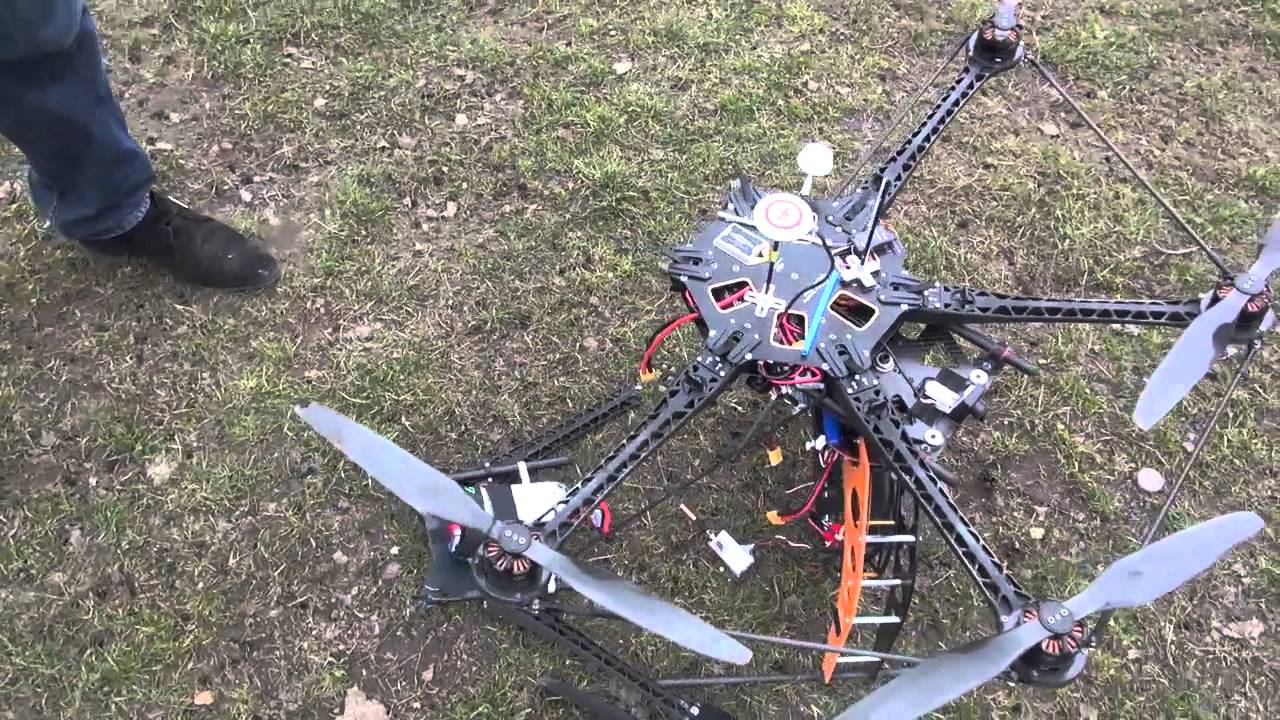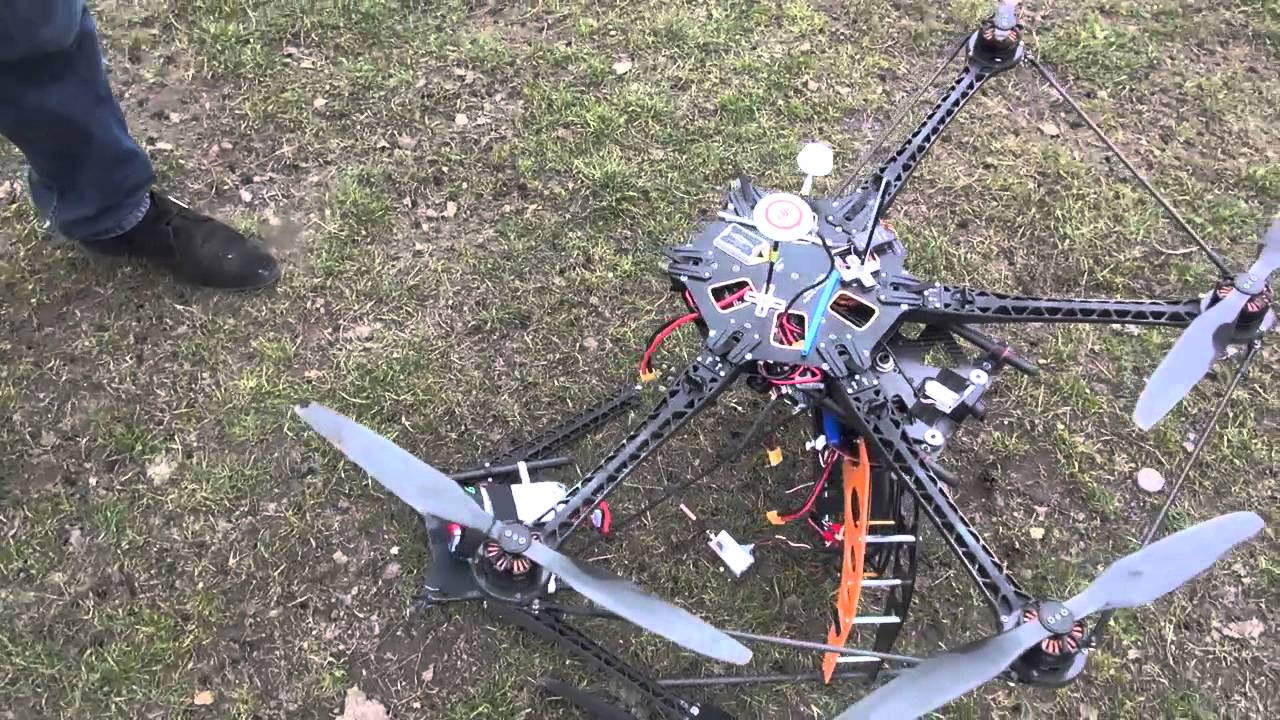Drone crash in Paris: This incident throws a spotlight on the increasingly complex relationship between rapidly advancing drone technology and urban environments. We’ll explore the circumstances surrounding the crash, delve into potential causes ranging from mechanical failure to human error, and examine the legal and regulatory implications. Prepare for a detailed look at this fascinating and concerning event.
This investigation will cover everything from the specific drone model and its capabilities to the immediate aftermath and public response. We’ll also examine the broader impact on drone safety regulations, technological advancements, and the future of drone use in densely populated areas. Get ready to uncover the whole story.
Incident Details
A drone crash occurred in Paris, causing a brief disruption and prompting investigations into the circumstances surrounding the event. While thankfully no serious injuries were reported, the incident highlighted the potential risks associated with drone operation in densely populated urban areas. The following details provide a clearer picture of what transpired.
Drone Specifications and Type
The drone involved in the Paris incident was reported to be a DJI Mavic 3, a popular model known for its high-quality camera and relatively compact size. This model boasts a maximum flight time of approximately 46 minutes, a top speed of 18 meters per second, and advanced obstacle avoidance features. However, the specific configurations and any modifications to the drone used in this particular incident are yet to be fully confirmed by official sources.
Crash Location and Nearby Landmarks
The drone crashed in the vicinity of the Eiffel Tower, a highly iconic and heavily trafficked area of Paris. While the precise coordinates remain under investigation, the crash location is believed to be within a few hundred meters of the famous landmark, placing it within a zone of restricted airspace. The proximity to such a prominent tourist attraction raises concerns about potential safety risks to both people and property.
Injuries and Damages
Fortunately, no injuries were reported as a direct result of the drone crash. However, there were minor damages to a nearby park bench, which sustained superficial scratches from the falling drone. The drone itself was significantly damaged and deemed unrecoverable. Further assessment is needed to determine the full extent of any property damage beyond the park bench.
Timeline of Events
The following table summarizes the timeline of events leading up to and following the drone crash:
| Time | Event | Location |
|---|---|---|
| 14:35 | Drone launched from an unknown location. | Near Eiffel Tower (Approximate) |
| 14:42 | Drone experienced a malfunction (cause currently under investigation). | Near Eiffel Tower (Approximate) |
| 14:45 | Drone crash landed. | Champ de Mars (Approximate) |
| 14:48 | Emergency services arrived at the scene. | Champ de Mars |
| 15:00 | Area secured and investigation commenced. | Champ de Mars |
Potential Causes
A drone crash, especially in a complex urban environment like Paris, can stem from a multitude of factors. Investigating these potential causes requires a systematic approach, considering both technical and human elements, as well as environmental influences. This section explores the various possibilities, weighing their likelihood based on typical drone malfunction scenarios.
Technical Malfunctions
Technical failures within the drone itself can be a primary cause of crashes. These can range from simple component failures like motor malfunctions or battery issues to more complex problems with the flight controller or GPS system. For example, a sudden loss of power in one or more motors could lead to an uncontrolled descent, while a GPS malfunction could result in the drone losing its orientation and drifting into obstacles.
A faulty sensor, such as a barometer responsible for altitude maintenance, could also cause the drone to descend unexpectedly. These issues often leave behind tell-tale signs in the drone’s flight logs, if recoverable.
That drone crash in Paris got everyone talking about safety regulations, right? It made me think about similar incidents, like that orlando drone show accident which highlighted the potential for large-scale malfunctions. Both incidents underscore the need for better preventative measures and improved drone technology to prevent future Paris-like mishaps.
Human Error
Pilot error is another significant factor. Inexperience, poor judgment, or negligence can easily lead to accidents. This could involve mistakes in pre-flight checks, misinterpreting sensor data, exceeding the drone’s operational limits (such as flying too far from the controller or in adverse weather), or failing to account for obstacles in the flight path. A pilot’s lack of awareness of airspace regulations or the surrounding environment could also contribute to a crash.
For instance, a pilot unfamiliar with Paris’s airspace restrictions might inadvertently fly into a restricted zone.
Weather Conditions
Adverse weather can severely impact drone performance. Strong winds can buffet the drone, making it difficult to control and potentially causing it to crash. Heavy rain or snow can damage the drone’s electronics or affect the performance of its sensors, compromising stability and control. Low visibility, due to fog or heavy rain, can also impair the pilot’s ability to visually monitor the drone’s flight, increasing the risk of collision.
A sudden downpour, for instance, could significantly reduce visibility and lead to a loss of control.
External Factors
External factors, beyond the drone and the pilot’s control, can also cause crashes. Radio frequency interference from other electronic devices can disrupt the communication link between the drone and its controller, resulting in a loss of control. Similarly, interference from other drones operating in the same area could cause signal conflicts. Wildlife, such as birds, could also collide with the drone, causing damage or loss of control.
A large bird striking a drone’s propellers, for example, could cause immediate failure.
Comparison of Potential Causes
| Cause | Likelihood | Supporting Evidence |
|---|---|---|
| Technical Malfunction (Motor Failure) | Medium | Drone flight logs showing sudden loss of motor power; physical damage to motors. |
| Pilot Error (Poor Judgment) | High | Witness accounts; violation of airspace regulations; lack of pre-flight checks. |
| Adverse Weather (Strong Winds) | Medium | Weather reports indicating strong winds at the time of the crash; witness accounts describing windy conditions. |
| External Factors (RF Interference) | Low | Evidence of other electronic devices operating nearby; analysis of radio frequency spectrum. |
Regulatory and Legal Aspects: Drone Crash In Paris

Drone operation in France, particularly within densely populated urban areas like Paris, is subject to a complex web of regulations designed to ensure public safety and prevent accidents. Understanding these regulations is crucial for both drone operators and those affected by drone incidents. This section will Artikel the key legal considerations following a drone crash in Paris.
French Drone Regulations in Urban Areas
French regulations governing drone use are primarily found within the General Directorate of Civil Aviation (DGAC) guidelines. These regulations cover various aspects, including drone registration, operator certification, flight restrictions in specific zones (like near airports or monuments), and operational limitations regarding altitude and distance from populated areas. Specific rules apply to the airspace over Paris, often requiring authorization from the DGAC for any flight.
These regulations aim to balance the benefits of drone technology with the need to protect public safety and privacy. Failure to comply with these rules can result in significant penalties. For example, flying near airports without authorization could lead to immediate seizure of the drone and substantial fines.
Legal Proceedings and Investigations Following a Drone Crash
Following a drone crash in Paris, several legal avenues could be pursued. The French authorities, likely involving the police and the DGAC, would investigate the incident to determine the cause and assign responsibility. This investigation might include examining the drone’s flight data recorder (if equipped), interviewing witnesses, and assessing the drone operator’s compliance with existing regulations. Depending on the severity of the incident and any resulting damage or injuries, civil lawsuits might be filed by affected parties against the drone operator.
Criminal charges could also be brought if negligence or recklessness is determined to be a contributing factor to the crash. For instance, a case involving significant property damage might lead to both civil and criminal proceedings.
Liabilities and Responsibilities of the Drone Operator
The drone operator bears primary responsibility for the safe operation of their drone. This includes adhering to all relevant regulations, ensuring the drone is in proper working order, and maintaining situational awareness during flight. Liability extends to any damage or injury caused by the drone, regardless of whether the operator intended for such harm to occur. Insurance coverage is highly recommended for drone operators to mitigate potential financial consequences resulting from accidents.
The operator’s liability might be reduced or eliminated if they can demonstrate that the crash was caused by a malfunction beyond their control and that all reasonable precautions were taken. However, proving this can be challenging and requires substantial evidence.
Penalties for Violating Drone Regulations in France
Penalties for violating French drone regulations can range from warnings and fines to imprisonment. The severity of the penalty depends on the nature and severity of the violation, as well as any resulting damage or injuries. Fines can be substantial, potentially reaching several thousand euros. In cases involving significant harm, criminal charges could lead to imprisonment. Furthermore, the drone itself could be confiscated.
The DGAC’s website provides detailed information on specific penalties for various infractions.
Steps Involved in the Legal Process Following a Drone Crash
The legal process following a drone crash can be complex and time-consuming. Here are the typical steps involved:
- Incident Reporting: The crash must be reported to the relevant authorities, typically the police and the DGAC.
- Investigation: Authorities conduct a thorough investigation to determine the cause of the crash and assign responsibility.
- Evidence Gathering: Evidence is collected, including witness statements, drone flight data, and any physical evidence.
- Legal Proceedings (Civil or Criminal): Depending on the circumstances, civil lawsuits or criminal charges may be filed.
- Settlement or Trial: Cases may be settled out of court or proceed to trial.
- Judgment and Penalties: If found liable, the drone operator faces penalties, including fines, imprisonment, or compensation to affected parties.
Public Reaction and Media Coverage
The drone crash in Paris elicited a wide range of public reactions, from shock and concern to fascination and debate. Media coverage played a significant role in shaping public perception, disseminating information, and influencing the overall narrative surrounding the incident. The event’s impact on the public’s view of drones was substantial, prompting discussions about safety regulations and technological advancements.
Public Reaction to the Drone Crash
Initial reactions were largely characterized by surprise and concern for public safety. Videos and images of the crash quickly circulated online, fueling discussions about the potential dangers of drones in populated areas. Many Parisians expressed apprehension about the incident, particularly given the location and the potential for significant harm. However, there was also a segment of the population that viewed the event with a degree of curiosity, prompting conversations about the technological capabilities and limitations of drones.
The overall sentiment was a mixture of anxiety and intrigue, highlighting the complex emotions associated with such an event.
Media Coverage of the Drone Crash, Drone crash in paris
News outlets provided comprehensive coverage of the incident, detailing the circumstances of the crash, the extent of any damage, and the ongoing investigations. Different media outlets adopted varying perspectives, some focusing on the potential safety risks associated with drones, others highlighting the technological advancements that make such accidents possible. For instance, some reports emphasized the need for stricter regulations, while others focused on the investigation into the potential causes of the malfunction.
The sheer volume of media coverage amplified the public’s awareness of the incident and its implications.
That drone crash in Paris really highlights the risks involved in aerial delivery, right? Thinking about safety, it makes you wonder about the infrastructure needed for widespread drone use, like those planned amazon drone delivery locations. Proper planning and safety protocols are key to avoid similar incidents, ensuring reliable and safe drone operations in the future, especially considering the Paris crash.
Social Media Discussions Regarding the Incident
Social media platforms became immediate forums for public discussion and speculation. The incident trended on platforms like Twitter and Facebook, with users sharing their opinions, concerns, and theories regarding the crash. The tone of the discussions was varied, ranging from serious concerns about safety and security to humorous memes and satirical comments. Some users expressed anger and frustration towards the drone operator, while others called for improved drone technology and stricter regulations.
The online conversation reflected the broader public sentiment, revealing a mixture of anxiety, curiosity, and debate surrounding the incident.
Impact of the Crash on Public Perception of Drones
The drone crash undeniably impacted public perception of drones, particularly in Paris. While many already had some awareness of the potential risks associated with drones, this incident served as a stark reminder of these dangers. Public trust in the safety of drone technology may have decreased in the short term, potentially leading to increased scrutiny of drone operations and a renewed push for stricter regulations.
However, it’s also possible that the incident could stimulate technological innovation aimed at improving drone safety features and preventing future accidents.
Hypothetical Press Release Summarizing the Event and its Aftermath
FOR IMMEDIATE RELEASEDrone Crash in Paris: Investigation Underway, Safety Measures EmphasizedPARIS, FRANCE – [Date] – A drone crash occurred in [Location in Paris] on [Date], resulting in [Description of damage and injuries]. Authorities immediately launched an investigation to determine the cause of the incident. Preliminary findings suggest [Brief summary of initial findings, if available].The incident has prompted renewed discussion about drone safety regulations and the need for robust oversight of drone operations in populated areas.
[Name of relevant authority] is committed to ensuring the safe integration of drone technology while prioritizing public safety. Further updates will be provided as the investigation progresses.[Contact Information]
Safety and Prevention Measures
Preventing drone crashes requires a multi-faceted approach encompassing rigorous safety protocols, comprehensive pilot training, and the adoption of advanced technologies. A combination of responsible operation and technological safeguards is crucial to mitigate risks and ensure safe drone flights.
Drone Operation Safety Protocols
Safe drone operation begins with a thorough understanding and adherence to established protocols. These protocols cover all phases of flight, from pre-flight checks to post-flight procedures. Ignoring even seemingly minor steps can significantly increase the likelihood of an incident. Operators must be aware of their surroundings, weather conditions, and any potential hazards before, during, and after flight.
This includes understanding and respecting airspace restrictions, avoiding populated areas, and maintaining visual line of sight whenever possible. Furthermore, regular maintenance and inspection of the drone are paramount to ensuring its continued airworthiness.
Best Practices for Preventing Drone Crashes
Pre-flight checks are non-negotiable. These checks ensure the drone’s systems are functioning correctly and ready for flight. This includes verifying battery levels, checking for any physical damage, confirming GPS signal strength, and calibrating the compass. During flight, maintaining a safe distance from obstacles and other aircraft is essential. Emergency procedures, such as battery failure protocols and controlled landings, should be practiced regularly to ensure a swift and safe response in unforeseen circumstances.
A comprehensive understanding of the drone’s capabilities and limitations is also crucial for preventing accidents.
Drone crashes are becoming increasingly common in urban areas, posing risks to both people and property. A recent incident highlighted this danger, focusing attention on the need for better drone regulations. For more details on a specific event, check out this report on a paris drone crash which caused significant disruption. Understanding these incidents helps us improve safety protocols surrounding drone operation in cities like Paris.
The Importance of Drone Pilot Training and Certification
Competent drone operation hinges on proper training and certification. Training programs equip pilots with the knowledge and skills necessary for safe and responsible drone operation. These programs typically cover topics such as airspace regulations, emergency procedures, pre-flight checks, and risk assessment. Certification validates a pilot’s proficiency and ensures they meet minimum competency standards, enhancing overall safety. Without proper training, pilots may lack the expertise to handle unexpected situations, potentially leading to accidents.
Furthermore, certification often provides insurance coverage, protecting the operator and third parties from liability.
Technological Advancements in Drone Safety
Technological advancements are continually improving drone safety. Features such as obstacle avoidance systems, GPS-based geofencing (restricting flight to specific areas), and automatic return-to-home functions significantly reduce the risk of crashes. Redundant systems, such as backup batteries and flight controllers, provide additional layers of safety. Advanced sensors and data analysis can also help pilots anticipate potential hazards and make informed decisions.
The ongoing development and integration of these technologies are transforming the drone industry, making it safer for both operators and the public.
Pre-Flight Checklist
A thorough pre-flight checklist is the cornerstone of safe drone operation. It helps ensure all systems are functioning correctly and reduces the risk of accidents. Here’s a visual representation:
- Battery Check: Verify battery charge level and condition. Ensure sufficient charge for the planned flight duration and have a spare battery readily available.
- Propeller Inspection: Check for damage or wear on propellers. Replace damaged propellers immediately.
- GPS Signal: Confirm a strong GPS signal is acquired before takeoff. Weak signals can lead to inaccurate positioning and control issues.
- Gimbal Calibration: Calibrate the gimbal to ensure smooth and accurate camera operation.
- Airspace Check: Verify the flight area is free from airspace restrictions and potential hazards (e.g., power lines, tall buildings).
- Visual Inspection: Conduct a thorough visual inspection of the drone for any physical damage or loose components.
- Emergency Procedures Review: Mentally rehearse emergency procedures, such as battery failure protocols and controlled landings.
- Weather Conditions: Check the weather forecast and avoid flying in adverse weather conditions (e.g., strong winds, rain, snow).
Impact on Drone Technology and Policy

The drone crash in Paris, while a singular event, carries significant implications for the future trajectory of drone technology and its associated regulatory frameworks. The incident serves as a stark reminder of the potential risks involved in drone operation, particularly in densely populated urban environments, and will undoubtedly influence both technological advancements and policy decisions moving forward. This impact will likely be felt across various sectors, from the design and manufacturing of drones to the legal and ethical considerations surrounding their use.The incident’s impact will extend beyond immediate safety concerns, prompting a reassessment of current drone technology and operational procedures.
The investigation into the cause of the crash, for example, may reveal weaknesses in existing drone systems, such as navigation software, battery life, or emergency fail-safes. This, in turn, will drive innovation and the development of more robust and reliable drone technologies. Simultaneously, the public scrutiny following the crash will pressure manufacturers and operators to prioritize safety features and enhance existing safety protocols.
Technological Advancements in Drone Safety
The Paris crash could accelerate the development and adoption of several key technological advancements aimed at improving drone safety. These include more sophisticated obstacle avoidance systems, improved GPS accuracy and redundancy, enhanced communication protocols for real-time monitoring and control, and fail-safe mechanisms to prevent uncontrolled descent or loss of control. For instance, we might see a faster rollout of anti-collision technologies similar to those being developed for autonomous vehicles, or a greater emphasis on redundant systems to mitigate the impact of single-point failures, like a GPS signal loss.
The increased demand for heightened safety will undoubtedly fuel investment in research and development within the drone industry.
Changes in Drone Regulations and Policies
The incident will likely lead to stricter regulations and policies governing drone operations, particularly in urban areas. We might see a tightening of airspace restrictions, mandatory registration requirements for all drones, more rigorous pilot training and licensing procedures, and increased penalties for violating regulations. There’s also a possibility of increased oversight by regulatory bodies, possibly including the implementation of more robust monitoring and enforcement systems to prevent unauthorized drone flights.
This could involve more advanced tracking technologies and greater collaboration between drone operators and air traffic control. For example, similar to the restrictions placed on commercial drone flights in many countries after various incidents, we might see stricter limits on drone weight, altitude, and operating hours in specific zones.
Long-Term Implications for the Drone Industry
The long-term impact on the drone industry will depend on the effectiveness of the response to the Paris crash. If the industry proactively addresses safety concerns and demonstrates a commitment to improving safety standards, the long-term consequences may be relatively minor. However, if the industry is perceived as slow to react or resistant to change, it could face significant setbacks, including reduced public trust, increased regulatory scrutiny, and potentially even limitations on drone applications.
The industry’s ability to adapt and innovate in response to this incident will be crucial in determining its future growth and sustainability.
Changes to Drone Safety Standards
The incident will likely result in a review and potential revision of existing drone safety standards. This could involve updating certification processes, enhancing testing protocols, and incorporating new safety requirements into drone designs and operating manuals. We can expect stricter standards for battery technology, software reliability, and emergency procedures. Furthermore, there could be an increased focus on incorporating features that enhance situational awareness, such as advanced sensor systems and real-time data analytics.
International cooperation on standardizing safety regulations will also be critical in ensuring consistent safety levels across different regions.
Recommendations for Improving Drone Safety
The Paris drone crash highlights the need for a multi-faceted approach to improving drone safety. The following recommendations are crucial:
- Implement mandatory drone registration and licensing programs with rigorous background checks for operators.
- Develop and enforce stricter airspace restrictions, particularly in populated areas.
- Mandate the use of advanced obstacle avoidance systems and redundant navigation systems on all drones.
- Invest in research and development of fail-safe mechanisms to prevent uncontrolled drone crashes.
- Improve communication protocols to enable real-time monitoring and control of drones.
- Establish clear guidelines and regulations for drone operation in different environments.
- Promote robust pilot training programs that emphasize safe operating procedures and emergency response.
- Develop and implement effective mechanisms for reporting and investigating drone incidents.
- Foster greater collaboration between drone manufacturers, operators, regulators, and researchers to improve drone safety.
Last Recap

The Paris drone crash serves as a stark reminder of the potential risks associated with unmanned aerial vehicles, highlighting the urgent need for robust safety protocols, stricter regulations, and ongoing technological improvements. By understanding the factors that contributed to this incident, we can work towards mitigating future risks and ensuring the safe integration of drones into our increasingly interconnected world.
The lessons learned here are crucial for the future of drone technology.
Common Queries
What type of damage did the drone crash cause?
This will depend on the specifics of the incident. The answer might range from minor property damage to significant injury, depending on the drone’s size, weight, and where it impacted.
Were there any witnesses to the drone crash?
Likely, yes. A crash in a populated area like Paris would probably have multiple witnesses. Their accounts would be important to investigations.
What is the typical response time for emergency services to drone incidents?
Response time varies depending on the location and severity of the incident. However, emergency services in Paris are generally quite responsive.
What insurance coverage is typically required for drone operation in France?
This will depend on the specific regulations and the type of drone operation. Third-party liability insurance is likely mandatory.
